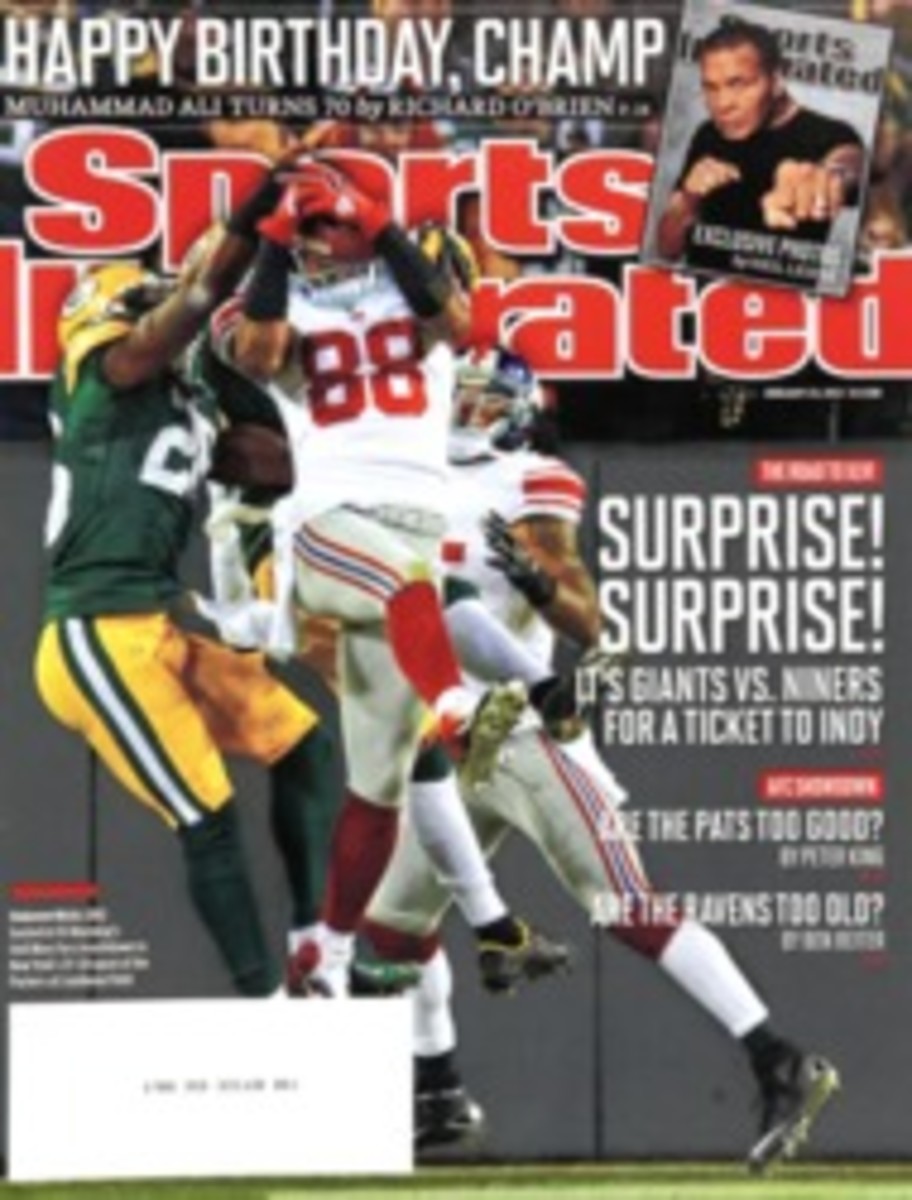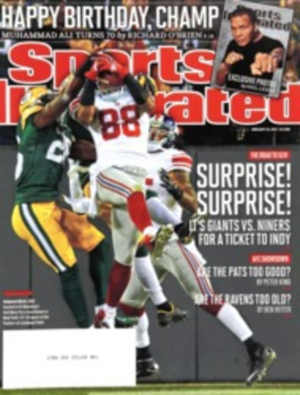
HAPPY BIRTHDAY, CHAMP
MUHAMMAD ALI TURNS 70
For photographer Neil Leifer, the four days he spent early this month at Muhammad Ali's house in Paradise Valley, Ariz., were both a revelation and wonderfully familiar. Leifer had read dire reports that after decades of battling Parkinson's disease, Ali was on his deathbed, yet Leifer found the fighter alert and cooperative. Though Ali seldom speaks (except with his wife, Lonnie, and other family members), he "doesn't miss a thing," Leifer says. The photographer, who began shooting for SI in 1958 and has taken more than 170 of the magazine's cover photos, went out to dinner with Ali and Lonnie and, at home, watched Ali undergo the extensive stretching routine that helps maintain his mobility. "After the session," Leifer says, "the difference in his walking was noticeable."
And when it came time to take the photos, says Leifer, who first shot Ali in 1963 and has photographed him countless times since then, "it was like the old days." Ali appeared to thrive on the engagement. "The shot with his fists up was his idea," says Leifer. "He was every photographer's and every writer's favorite subject, whether you liked him or not, because he always made you look good."
The nameCassius Clay first appeared in the pages of SI in 1958. The reference was to a 19th-century Kentucky politician and emancipationist. Two years later, in our April 18, 1960, issue, the name showed up again, this time attached to a decidedly more contemporary figure. That week's FOR THE RECORD section listed the "20 diligent-punching young men" who had qualified for the U.S. Olympic Boxing Trials, and it noted that Clay, a 178-pounder from Louisville who was named after the statesman, had been declared the outstanding boxer of the AAU tournament. He would go on, of course, to become the outstanding boxer of, well, forever, and he would show up countless more times in SI and appear on 38 covers. In many ways he and the magazine came of age together.
Now Ali is turning 70. They're planning a big birthday bash for him in Las Vegas on Feb. 18. (Never mind that his actual birthday is Jan. 17.) The celebration—an "undisputed heavyweight event" at the MGM Grand Garden Arena that will be recorded and broadcast on ABC a week later—is a gala occasion for celebrities and the public to gather for a feel-good, charity-benefiting (and ratings-driving) tribute to the man who is perhaps the one universally beloved figure in the U.S. today.
But amid the accolades and the warm glow from the candles, it's worth leaning back on the ropes to consider what a profound change this lovefest represents. Today, with Ali physically diminished and every self-celebrating athlete unwittingly channeling the Greatest, it's almost impossible to see just how original and transformative a figure he was—and how divisive and even reviled he remained through much of his career. If changing times have brought him acceptance and affection, let's recall Ali's singular role in bringing about much of the change. Just as he did in those terrible wars with Joe Frazier, George Foreman and Ken Norton, Ali on the world stage played for the highest stakes, at a level of risk unthinkable in today's sports culture.
These days a petulant tweet by Ozzie Guillen is hailed as an act of courage, while LeBron James's appearance in an edgy new ad campaign is treated like a statement of principle. A name change, meanwhile, is greeted not with controversy but merely with a newly lettered jersey (WORLD PEACE). By contrast, Ali, whose dancing, hands-down style in the ring initially drew harrumphs from the boxing establishment, faced far more withering fire for his actions outside the ropes.
After his upset win over Sonny Liston to take the world heavyweight title in 1964, the wide-eyed, 22-year-old Clay had shouted to the assembled press, "I shook up the world!" But it was his announcement soon after that he had joined the Nation of Islam and changed his name to Muhammad Ali that had the real seismic effect. Until then Americans had expected black athletes to follow the example of the quiet, apolitical Joe Louis. Columnist Jimmy Cannon wrote in the New York World Journal & Telegram that Ali (Cannon called him Clay, of course) was "a vicious propagandist for a spiteful mob that works the religious underworld." It was a view shared by most of the establishment media, which largely refused to use what Cannon termed the boxer's "Black Muslim brand name."
You think James got slammed for the Decision? Ali, too, once made a long-anticipated and controversial choice. Only it took place off-camera in a former Houston post office building, where on April 28, 1967, he declined to step forward and be inducted into the U.S. Army at the height of the Vietnam War. This refusal, on religious grounds, got Ali arrested and stripped of his title. Two months later he was convicted of draft evasion, fined $10,000 and sentenced to five years in jail, but he stayed free on appeal, and in '71 the conviction was overturned by the U.S. Supreme Court. Along the way Ali lost 3½ years in the prime of his career.
Ali's most famous quote explaining his refusal to go to war, "I ain't got no quarrel with those Vietcong," seems the very model of the prima donna athlete's egocentric worldview, but a quote later in the same interview isn't as often remembered: "No Vietcong ever called me n-----." The focus there went far beyond self.
Ali may have been a genius at self-promotion (his joyous little verse Me/Wheee! is said to be the shortest poem in the English language), but what he really promoted, and still does today, is connection. His delight in engaging others is what made him as willing to spend an hour with a reporter from a high school paper as with a writer from SI. It's what drove him to travel relentlessly, even as his illness slowed and finally silenced him, to promote peace from Ireland to Afghanistan. It was the inspiration for the creation six years ago of the Muhammad Ali Center in Louisville, a $60 million facility dedicated to carrying on his legacy. There, last Saturday night, with Lonnie beside him, Ali soaked up the good wishes of 350 guests at an early birthday party.
Maybe the best gift one could give Ali now would be to realize just what it took to get to such a moment. So, for the record, Champ, 52 years after you first appeared in SI, happy birthday.
"He was every photographer's and every writer's favorite subject, whether you liked him or not," Leifer says, "because he always made you look good."
Today it's almost impossible to grasp how original and transformative a figure Ali was—and how divisive he remained through much of his career.
1 Leifer's photo session with Ali in Paradise Valley was only the latest in a 50-year series.
2 Behind Ali, the fighter in his prime was captured on canvas by painter LeRoy Neiman.
3 Twice-weekly stretching sessions with a personal trainer help keep Ali limber.
4 With Lonnie by his side, the Champ assayed one of what would be many birthday cakes.
1960s
FEBRUARY 24, 1964
MARCH 9, 1964
NOVEMBER 16, 1964
MAY 24, 1965
JUNE 7, 1965
NOVEMBER 22, 1965
APRIL 11, 1966
FEBRUARY 6, 1967
JULY 10, 1967
MAY 5, 1969
1970s
MARCH 1, 1971
MARCH 15, 1971
JULY 26, 1971
APRIL 23, 1973
FEBRUARY 4, 1974
OCTOBER 28, 1974
NOVEMBER 11, 1974
DECEMBER 23, 1974
SEPTEMBER 15, 1975
OCTOBER 13, 1975
MARCH 1, 1976
OCTOBER 10, 1977
SEPTEMBER 25, 1978
1980s
APRIL 14, 1980
SEPTEMBER 29, 1980
OCTOBER 13, 1980
APRIL 25, 1988
NOVEMBER 15, 1989
1990s
JANUARY 13, 1992
SEPTEMBER 30, 1996
JULY 13, 1998
JULY 26, 1999*
*Ali also appeared on six other covers
PHOTO
PHOTOGRAPH BY NEIL LEIFER
Outside his home in Paradise Valley, Ariz., Ali brandishes the fists that once knocked out such feared fighters as Liston and Foreman.
PHOTO
PETER READ MILLER (ATLANTA GAMES)
Ali's surprise appearance to light the torch at the 1996 Games thrilled the crowd in Atlanta's Olympic Stadium and millions more watching at home on TV.
PHOTO
MARVIN NEWMAN (ROME GAMES)
1960 Clay stood on a podium in the Olympic ring in Rome after he won the light heavyweight gold medal match against Poland's Zbigniew Pietrzykowski, capping his amateur career and setting himself on a path to become the professional heavyweight champion of the world.
PHOTO
RICHARD MEEK
PHOTO
NEIL LEIFER
PHOTO
HERB SCHARFMAN
PHOTO
RICHARD MEEK
PHOTO
GEORGE SILK
PHOTO
NEIL LEIFER
PHOTO
TONY TRIOLO
PHOTO
NEIL LEIFER
PHOTO
HERB SCHARFMAN/LIFE MAGAZINE
PHOTO
PHILLIP LEONIAN
PHOTO
ROBERT HANDVILLE
PHOTO
TONY TRIOLO
TWO PHOTOS
NEIL LEIFER
PHOTO
TONY TRIOLO
PHOTO
DONALD MOSS
PHOTO
DAVID BERGMAN (ALI WITH LEIFER)
PHOTO
KEN REGAN/CAMERA 5
THREE PHOTOS
NEIL LEIFER
PHOTO
CO RENTMEESTER
PHOTO
NEIL LEIFER
PHOTO
JAMES DRAKE
PHOTO
MANNY MILLAN
PHOTO
LANE STEWART
PHOTO
JOHN IACONO
PHOTO
GREGORY HEISLER
PHOTO
MARK HANAUER
PHOTO
NEIL LEIFER
PHOTO
WALTER IOOSS JR.
TWO PHOTOS
NEIL LEIFER
THREE PHOTOS

